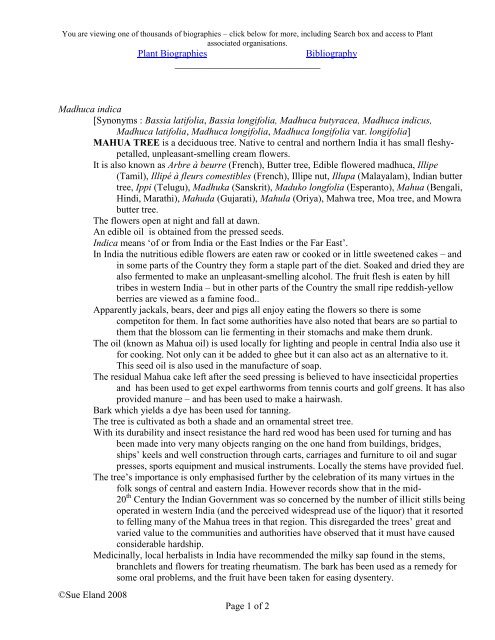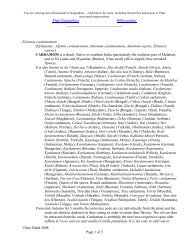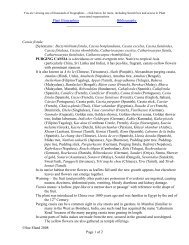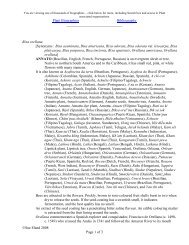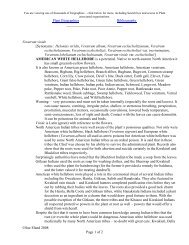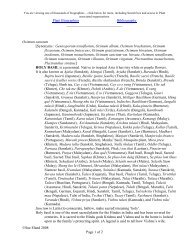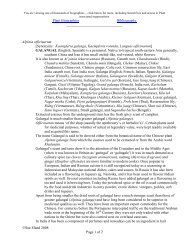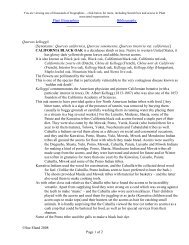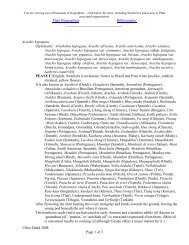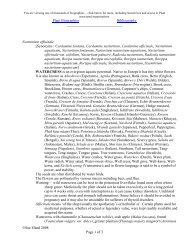Mahua trees - Plant Biographies
Mahua trees - Plant Biographies
Mahua trees - Plant Biographies
You also want an ePaper? Increase the reach of your titles
YUMPU automatically turns print PDFs into web optimized ePapers that Google loves.
You are viewing one of thousands of biographies – click below for more, including Search box and access to <strong>Plant</strong><br />
associated organisations.<br />
<strong>Plant</strong> <strong>Biographies</strong><br />
Bibliography<br />
______________________________<br />
Madhuca indica<br />
[Synonyms : Bassia latifolia, Bassia longifolia, Madhuca butyracea, Madhuca indicus,<br />
Madhuca latifolia, Madhuca longifolia, Madhuca longifolia var. longifolia]<br />
MAHUA TREE is a deciduous tree. Native to central and northern India it has small fleshypetalled,<br />
unpleasant-smelling cream flowers.<br />
It is also known as Arbre à beurre (French), Butter tree, Edible flowered madhuca, Illipe<br />
(Tamil), Illipé à fleurs comestibles (French), Illipe nut, Illupa (Malayalam), Indian butter<br />
tree, Ippi (Telugu), Madhuka (Sanskrit), Maduko longfolia (Esperanto), <strong>Mahua</strong> (Bengali,<br />
Hindi, Marathi), Mahuda (Gujarati), Mahula (Oriya), Mahwa tree, Moa tree, and Mowra<br />
butter tree.<br />
The flowers open at night and fall at dawn.<br />
An edible oil is obtained from the pressed seeds.<br />
Indica means ‘of or from India or the East Indies or the Far East’.<br />
In India the nutritious edible flowers are eaten raw or cooked or in little sweetened cakes – and<br />
in some parts of the Country they form a staple part of the diet. Soaked and dried they are<br />
also fermented to make an unpleasant-smelling alcohol. The fruit flesh is eaten by hill<br />
tribes in western India – but in other parts of the Country the small ripe reddish-yellow<br />
berries are viewed as a famine food..<br />
Apparently jackals, bears, deer and pigs all enjoy eating the flowers so there is some<br />
competiton for them. In fact some authorities have also noted that bears are so partial to<br />
them that the blossom can lie fermenting in their stomachs and make them drunk.<br />
The oil (known as <strong>Mahua</strong> oil) is used locally for lighting and people in central India also use it<br />
for cooking. Not only can it be added to ghee but it can also act as an alternative to it.<br />
This seed oil is also used in the manufacture of soap.<br />
The residual <strong>Mahua</strong> cake left after the seed pressing is believed to have insecticidal properties<br />
and has been used to get expel earthworms from tennis courts and golf greens. It has also<br />
provided manure – and has been used to make a hairwash.<br />
Bark which yields a dye has been used for tanning.<br />
The tree is cultivated as both a shade and an ornamental street tree.<br />
With its durability and insect resistance the hard red wood has been used for turning and has<br />
been made into very many objects ranging on the one hand from buildings, bridges,<br />
ships’ keels and well construction through carts, carriages and furniture to oil and sugar<br />
presses, sports equipment and musical instruments. Locally the stems have provided fuel.<br />
The tree’s importance is only emphasised further by the celebration of its many virtues in the<br />
folk songs of central and eastern India. However records show that in the mid-<br />
20 th Century the Indian Government was so concerned by the number of illicit stills being<br />
operated in western India (and the perceived widespread use of the liquor) that it resorted<br />
to felling many of the <strong>Mahua</strong> <strong>trees</strong> in that region. This disregarded the <strong>trees</strong>’ great and<br />
varied value to the communities and authorities have observed that it must have caused<br />
considerable hardship.<br />
Medicinally, local herbalists in India have recommended the milky sap found in the stems,<br />
branchlets and flowers for treating rheumatism. The bark has been used as a remedy for<br />
some oral problems, and the fruit have been taken for easing dysentery.<br />
©Sue Eland 2008<br />
Page 1 of 2
©Sue Eland 2008<br />
Page 2 of 2


